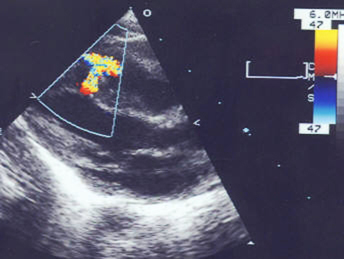Resumo
Definição
História e exame físico
Principais fatores diagnósticos
- presença de fatores de risco
- sopro sistólico na região paraesternal esquerda
- deficit no crescimento
- dispneia
Outros fatores diagnósticos
- infecções pulmonares recorrentes
- componente pulmonar forte da segunda bulha cardíaca
- cianose
- baqueteamento digital
- infarto do miocárdio recente (geralmente dentro de um período de 3 a 5 dias)
- trauma recente
Fatores de risco
- história familiar de cardiopatia congênita
- Síndrome de Down (trissomia do cromossomo 21)
- consumo materno de bebidas alcoólicas durante a gestação
- tabagismo materno durante a gravidez
Investigações diagnósticas
Primeiras investigações a serem solicitadas
- ecocardiografia
- radiografia torácica
- eletrocardiograma (ECG)
Investigações a serem consideradas
- ressonância nuclear magnética (RNM) cardíaca
- tomografia computadorizada (TC) cardíaca
- cateterismo cardíaco
Algoritmo de tratamento
congênito: pequeno
congênito: médio ou grande
adquirida
Colaboradores
Autores
Kul Aggarwal, MD, MRCP, FACC

Professor of Clinical Medicine
University of Missouri
Columbia
MO
Declarações
KA declares that he has no competing interests.
Agradecimentos
Dr Kul Aggarwal would like to gratefully acknowledge Professor Zuhdi Lababidi, a previous contributor to this topic.
Declarações
ZL declares that he has no competing interests.
Revisores
Michael Cheung, BSc (Hons), MB ChB, MRCP, FRACP
Acting Head
Department of Cardiology
Royal Children's Hospital
Melbourne
Australia
Declarações
MC declares that he has no competing interests.
Sachin Khambadkone, MD, DCH, DNB
Consultant Paediatric Cardiologist and Honorary Senior Lecturer
Great Ormond Street Hospital and Institute of Child Health
London
UK
Declarações
SK declares that he has no competing interests.
Tain-Yen Hsia, MD
Attending Pediatric Cardiothoracic Surgeon
Medical University of South Carolina Children's Hospital
Charleston
SC
Declarações
TYH declares that he has no competing interests.
Créditos aos pareceristas
Os tópicos do BMJ Best Practice são constantemente atualizados, seguindo os desenvolvimentos das evidências e das diretrizes. Os pareceristas aqui listados revisaram o conteúdo pelo menos uma vez durante a história do tópico.
Declarações
As afiliações e declarações dos pareceristas referem--se ao momento da revisão.
Referências
Principais artigos
Stout KS, Daniels CJ, Aboulhosn JA, et al. 2018 AHA/ACC guideline for the management of adults with congenital heart disease: a report of the American College of Cardiology/American Heart Association Task Force on Clinical Practice Guidelines. Circulation. 2019 Apr 2;139(14):e698-800.Texto completo Resumo
Baumgartner H, De Backer J, Babu-Narayan SV, et al. 2020 ESC Guidelines for the management of adult congenital heart disease. Eur Heart J. 2021 Feb 11;42(6):563-645.Texto completo Resumo
Expert Panels on Cardiac Imaging and Pediatric Imaging; Krishnamurthy R, Suman G, Chan SS, et al. ACR appropriateness criteria® congenital or acquired heart disease. J Am Coll Radiol. 2023 Nov;20(11s):S351-81.Texto completo Resumo
John AS, Jackson JL, Moons P, et al. Advances in managing transition to adulthood for adolescents with congenital heart disease: a practical approach to transition program design: a scientific statement from the American Heart Association. J Am Heart Assoc. 2022 Apr 5;11(7):e025278.Texto completo Resumo
Artigos de referência
Uma lista completa das fontes referenciadas neste tópico está disponível para os usuários com acesso total ao BMJ Best Practice.

Diagnósticos diferenciais
- Defeito do septo atrial
- Persistência do canal arterial
- Regurgitação mitral
Mais Diagnósticos diferenciaisDiretrizes
- ACR appropriateness criteria: congenital or acquired heart disease
- Advances in managing transition to adulthood for adolescents with congenital heart disease
Mais DiretrizesConectar-se ou assinar para acessar todo o BMJ Best Practice
O uso deste conteúdo está sujeito ao nosso aviso legal